Maiden Voyage of the Glasshopper.
-----------------------------------------------------------------------------------------
August 8th 2008 the Glasshopper is ready to launch. Next weeks the interior will be finished as well as lots of details.

.

In January 2004 I had the initial concept idea and here it is.
The shape of the exterior is consistently planar above and beneath the waterline, meaning that all surfaces are flat instead of curved.
.


A lot of spectators came to watch.
.
.

The draught is perfect and meets the estimated displacement which is very important to be able to pass the low bridges 'en route'.
.

Typical Dutch view.

Steering position.
.

.

Touch screen computer controlled technical installations.
Overview of the main electrical systems.
.

Optimal visibility for the skipper.
.


The big picture.

Just a detail.
.

A crystal reflecting the environment.

Satisfied and happy people after the succesful first trip.
.

Glasshopper at its berth. .

Time to finish the interior.
.

To be ready to welcome guests from all over the world.
.





















































